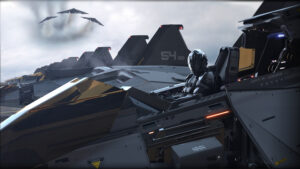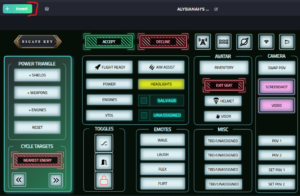[vc_row][vc_column width=”2/3″][vc_column_text]
Show Transcript
The majority of MISC’s business comes from the production of their heavy industrial division. One of MISC’s claims to fame is their technology partnership with the Xi’an, which came about due to the popularity of MISC ships within their culture. That popularity led to MISC becoming the only Human spacecraft corporation to sign a lend-lease agreement with the Xi’an. The details of which, are a closely guarded secret.
MISC Hull A
The Hull A is the smallest and least expensive in the Hull series. It’s ideal for someone who is just starting out in freight hauling and is looking for a dedicated cargo vessel. In size, it’s most similar to the Aurora, Mustang or Reliant Kore but is less versatile. The aforementioned ships are configured with more firepower, allowing them to also be used in combat. This is not the case for the Hull A.
The Hull A is 22 meters in length. Has a mass of roughly fourteen thousand kilograms. Supports 1 crew station. And holds 48 cargo units. In addition to being a dedicated hauler, the Hull A is often used as a station-to-orbit ferry. The size and limited capabilities is one of the reasons the Hull A didn’t meet my needs even as someone who will only casual participate in cargo hauling. But I think it’s a good starter option for a dedicated hauler.
MISC Hull B
Next in the Hull series is the Hull B. It’s a larger and more rugged option than the Hull A. It can be compared to the Freelancer base model but here again, it’s less flexible in the non-cargo hauling features, lacking a long range scanner and is only equipped with one crew station. However, the lack of versatility is compensated for by providing additional storage capacity. Even the Freelancer MAX’s storage capabilities don’t match the Hull B.
The Hull be is 49 meters in length and weighs roughly sixty-seven thousand kilograms. It supports 1 crew station and can transport 384 cargo units. As you can see, that’s a significant jump in storage units from the Hull A’s 48.
The Hull B is the variant I purchased. For smaller, on the go hauling, I have a Reliant Kore. And although I also own the Freelancer Mercantile, I’m going to be using that for multi-crew missions and tour bus for family and friends. For opportunistic hauling with a bit of intent, the Hull B hit the right chord for me.
MISC Hull C
The Hull C. This is where the Hull series makes a significant leap in cargo transport size. The Hull C is one of the more common ships seen transporting cargo around the galaxy. It’s the variant most produced from the Hull series and is considered the most versatile.
The Hull C is intended to hit the ‘sweet spot’ between the smaller single-person transports and the massive super-freighters that make up the rest of the line. It offers modularity while maintaining a modicum of maneuverability.
Considering the Hull series sequentially, the Hull C is the first in the series to employ the spindle modularity cargo support mechanic. This unique design allows the ship to shrink and grow to match your cargo hauling needs.
The ship itself is 105 meters in length and weighs just under 290,00 kilograms. It supports 3 crew stations and 4608 cargo units. That’s more than 10 times what Hull B can haul.
MISC Hull D
Now we enter the realm of large operation super-freighters. It’s the Hull D, a massive ship built around a rugged frame. The Hull D is affordable enough to be operated by mid-sized organizations and companies. It’s often used as a flagship for mercantile operations. However, their bulk means that they should be operated with escort fighters while not in safe space. While it is equipped with Size 2 and 3 gimbal mounts as weapons support, it’s size would make it an easy target regardless. The UEE military uses modified Hull D as part of their supply chain, arming and refueling the soldiers on the front line.
The Hull D cab is 206 meters and weighs over 1 million kilograms. It supports 5 crew stations and 20,736 cargo units. This is for serious…dedicated…cargo transport.
MISC Hull E
Last in the series is the behemoth, Hull E. It’s the largest specialized freighter available on the market. The Hull E is generally owned by major corporations and operated with a high degree of planning. To make your excursions profitable, you want to do careful logistics planning that optimizes your route for pickup and delivery. And ensure you have payloads big enough and profitable enough to warrant undocking a Hull E.
It’s essential to understand that the lack of maneuverability inherent in such a large ship means that it is a target for pirates and raiders. Anyone planning to operate one should be careful about equipping turrets and providing reliable escort. The Hull E isn’t for the fly by night cargo operator. It’s intended for large scale dedicated transport operations.
You Might Also Like:
Casual Citizen Episode 16 – MISC Hull Series
[/vc_column_text][/vc_column][vc_column width=”1/3″][vc_gallery el_id=”gallery-151292″ medias=”48793,48792,48436,48796,48794,48795″ gutter_size=”3″ media_items=”title,media|lightbox|original” screen_lg=”1000″ screen_md=”600″ screen_sm=”480″ single_text=”under” single_overlay_opacity=”50″ single_padding=”2″ lbox_title=”yes”][/vc_column][/vc_row]






